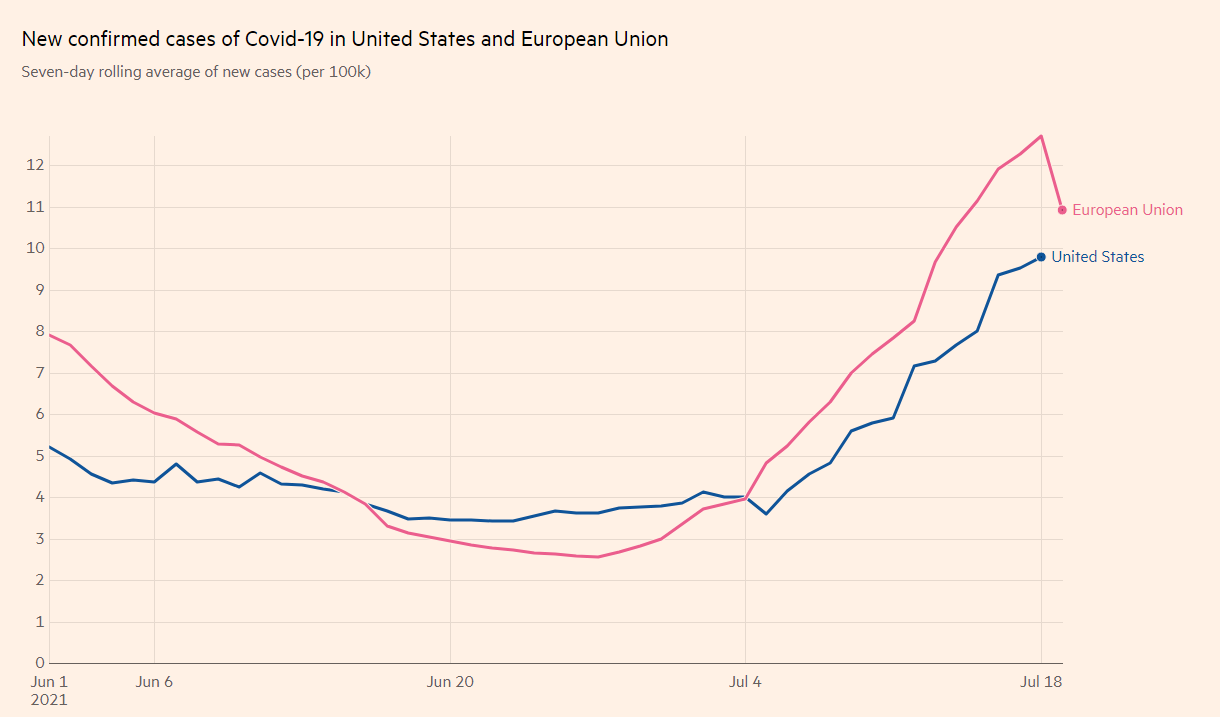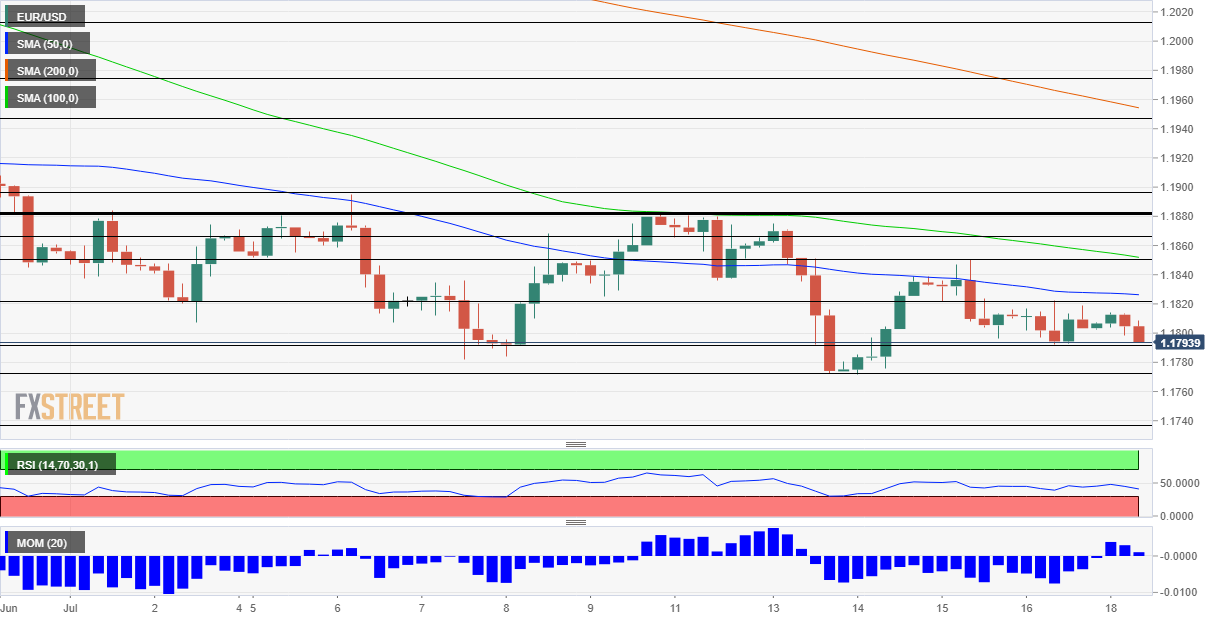- EUR/USD has been struggling to hold onto the 1.18 level amid a risk-off mood.
- Concerns about the Delta variant and rising US inflation could push the pair lower.
- Monday's four-hour chart is showing bears have the upper hand.
Summer fun? Not in financial markets, which have been gripped by fears that could cause volatility and push EUR/USD lower. The highly transmissible Delta COVID-19 strain is spreading rapidly all over the world and threatens to dampen economic growth.
Source: FT
Cases are on the rise on both sides of the Atlantic and mostly affecting the unvaccinated – especially when it comes to severe illness and deaths. In Europe, travel and activity restrictions could weigh on the nascent recovery – and summer holidays.
Moreover, the European Central Bank is also watching the data ahead of its meeting on Thursday, and the ascending infections could bolster the doves – perhaps toward extending the bond-buying scheme. More euros printed could weigh on the common currency.
While the US is also experiencing a surge in covid cases, the effect on the currency could be different, as the dollar is a safe-haven currency. The greenback benefits from inflows in times of trouble.
Another factor giving investors a cause for a pause in rising US inflation. Apart from the higher-than-estimated jump in the Consumer Price Index – 5.4% yearly, highest in 13 years – expectations for future increases are also moving higher. The University of Michigan's Consumer Sentiment Index showed a drop in confidence in July, but that shoppers project prices to rise.
The Federal Reserve is watching these surveys closely to gauge if inflation has taken hold in consumers' minds – something that is beyond a temporary leap in prices related to the quick US reopening. If the Fed inches closer to tapering down its bond-buying scheme, the dollar could rise.
Overall, the risk-off mood in the market is pointing to further falls for euro/dollar.
EUR/USD Technical Analysis
Euro/dollar has been losing its upside momentum on the four-hour chart and remains below the 50, 100 and 200 Simple Moving Averages. Moreover, it has been setting lower lows and lower highs.
Overall, bears are in control.
Critical support awaits at 1.1771, which is July's low. Further down, the next levels to watch date back to early in the year, and they include 1.1740, 1.1717 and 1.17.
Some resistance is at 1.1820, which capped the pair in recent days and then 1.1850, a swing high from last week. Further above, 1.1880 and 1.19 await bulls.
Delta Doom is set to storm America, the dollar could emerge as top dog
Information on these pages contains forward-looking statements that involve risks and uncertainties. Markets and instruments profiled on this page are for informational purposes only and should not in any way come across as a recommendation to buy or sell in these assets. You should do your own thorough research before making any investment decisions. FXStreet does not in any way guarantee that this information is free from mistakes, errors, or material misstatements. It also does not guarantee that this information is of a timely nature. Investing in Open Markets involves a great deal of risk, including the loss of all or a portion of your investment, as well as emotional distress. All risks, losses and costs associated with investing, including total loss of principal, are your responsibility. The views and opinions expressed in this article are those of the authors and do not necessarily reflect the official policy or position of FXStreet nor its advertisers. The author will not be held responsible for information that is found at the end of links posted on this page.
If not otherwise explicitly mentioned in the body of the article, at the time of writing, the author has no position in any stock mentioned in this article and no business relationship with any company mentioned. The author has not received compensation for writing this article, other than from FXStreet.
FXStreet and the author do not provide personalized recommendations. The author makes no representations as to the accuracy, completeness, or suitability of this information. FXStreet and the author will not be liable for any errors, omissions or any losses, injuries or damages arising from this information and its display or use. Errors and omissions excepted.
The author and FXStreet are not registered investment advisors and nothing in this article is intended to be investment advice.
Recommended Content
Editors’ Picks
AUD/USD jumps above 0.6500 after hot Australian CPI data

AUD/USD extended gains and recaptured 0.6500 in Asian trading, following the release of hotter-than-expected Australian inflation data. The Australian CPI rose 1% in QoQ in Q1 against 0.8% forecast, providing extra legs to the Australian Dollar upside.
USD/JPY hangs near 34-year high at 154.88 as intervention risks loom

USD/JPY is sitting at a multi-decade high of 154.88 reached on Tuesday. Traders refrain from placing fresh bets on the pair as Japan's FX intervention risks loom. Broad US Dollar weakness also caps the upside in the major. US Durable Goods data are next on tap.
Gold price cautious despite weaker US Dollar and falling US yields

Gold retreats modestly after failing to sustain gains despite fall in US Treasury yields, weaker US Dollar. XAU/USD struggles to capitalize following release of weaker-than-expected S&P Global PMIs, fueling speculation about potential Fed rate cuts.
Crypto community reacts as BRICS considers launching stablecoin for international trade settlement

BRICS is intensifying efforts to reduce its reliance on the US dollar after plans for its stablecoin effort surfaced online on Tuesday. Most people expect the stablecoin to be backed by gold, considering BRICS nations have been accumulating large holdings of the commodity.
US versus the Eurozone: Inflation divergence causes monetary desynchronization

Historically there is a very close correlation between changes in US Treasury yields and German Bund yields. This is relevant at the current juncture, considering that the recent hawkish twist in the tone of the Fed might continue to push US long-term interest rates higher and put upward pressure on bond yields in the Eurozone.

